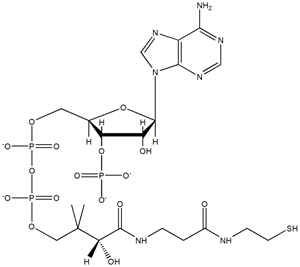Coenzymes are small organic molecules that carry chemical substances between enzymes within the cell. These molecules are necessary for enzymes to be active but do not form part of the enzyme structure.
Most co-enzymes are involved as carrier molecules, transferring, electrons and ions (H+ ) between reactants during biological reactions.
NADH, NADPH and FADH are co-enzymes that transfer electrons and ions during cellular respiration.
In metabolism, coenzymes are involved in :
-the transfer of molecules, such as coenzyme A, shown on the right, which transports an acetic acid molecule across the mitochondrial membrane, and adenosine triphosphate (ATP) which transport a phosphate group;
-
redox reactions, such as nicotinamide adenine dinucleotide (NAD+).

Coenzymes are consumed and recycled during metabolism, with an enzyme adding a chemical group to the coenzyme and another enzyme removing it.
For example, the enzyme ATP synthase adds a phophate group to ADP converting it to ATP while a group of enzymes known as kinases strip the phosphate group off the ATP converting it to ADP ( adenosine diphosphate)